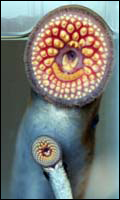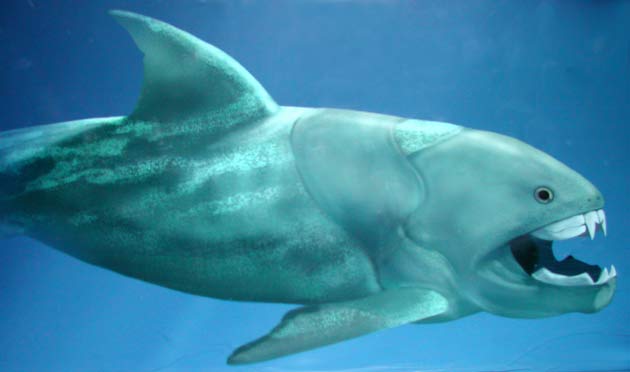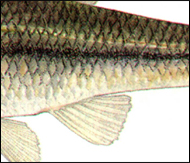Major groups of fishes



 See more images.
See more images.Hagfish, Myxinomorphi
Characteristics:
• No dorsal or paired fins
• Barbels present
• No scales or external armor
• No true jaw, round mouth, many teeth
• Cartilaginous skeleton
• Gills (holes on side?)
• Mucous pores along body
• Body fluids isotonic with seawater
• Feed by scavenging
• Able to knot body
• Few (~30) large eggs
• Long gestation
• No metamorphosis
• No cerebellum
• No spiral valve or cilia in intestinal tract
• Marine
• ~ 70 living species
More:
• Hagfish Aren't so Horrible After All
• Video - Feeding on dead whale
• Video - Slime production
Photographer - Dr. Paddy Ryan. Image used with permission.


 See more images.
See more images.Lamprey, Petromyzontomorphi.
Characteristics:
• 7 gill holes on each side
• No paired fins
• One or two dorsal fins
• No scales
• Cartilaginous skeleton
• Small cerebellum
• Spiral valve or cilia in intestinal tract
• Many non-yolky eggs
• Undergoes metamorphosis
• Dies after spawning
• No true jaw, has teeth
• ... skeleton
• Freshwater and marine
• ~ 38 living species
More:
Photographer - Dave Brenner. Permission - Michigan Sea Grant.
Hagfishes •
Lampreys •
Ostracoderms •
Conodonts •
JAWS
Placoderms •
Cartilaginous fishes •
Acanthodians •
Bony fishes •


 See more images.
See more images.
Image above - from R. J. Aldridge, D. E. G. Briggs, M. P. Smith, E. N. K. Clarkson and N. D. L. Clark, 1993. The Anatomy of Conodonts. In Philosophical Transactions: Biological Sciences, Vol. 340, No. 1294 (Jun. 29, 1993), pp. 405-421, published by The Royal Society.
Image below - from Mark A. Purnell and Philip C. J. Donoghue, 1997. Architecture and functional morphology of the skeletal apparatus of ozarkodinid conodonts. In Phil. Trans. R. Soc. Lond. B 29, November 1997 vol. 352 no. 1361 1545-1564, published by The Royal Society.

EXTINCT
Until recently, no one knew the owners of these fossilized miniature teeth or whether they were actually used for eating. THey have been revealed to be tiny vertebrates. Abundant "teeth" were found in common in ... age sediments, but impressions of the owners were elusive, suggesting a soft-body that .... In 1983, the first impressions of the body were found together with undisturbed location of the teeth. This fossil find finally showed that the strutures were indeed multiple rows of teeth possessed by a minnow-sized fish-like creature that was a vertebrate. This animal is the first one that had the ability to form the bone and tooh materials - dentin and enamle that are unique to vertebratesss. Chevron-shaped muscles.

More about conodonts
Conodonts in Vertebrate Evolution


EXTINCT
Ostracoderms - early jawless armored fishes. Like their predecessors the lampreys and hagfish, ostracoderms are jawless; however, unlike the soft-bodied agnathans, their heads are covered with bony armor. Bone material that starts out being used for armor is now used by sharks to armor their skin, and by vertebrates for bone and teeth.

Ostracoderms are generally small, being a foot or less in length.
Includes several taxonomic groups that all went extinct by the end of the Devonian when more advanced materials and body designs appeared.
 See more images.
See more images.TBA, TBA
Characteristics:
• No paired fins or early equivalent of pectoral fins
• Head armor
• No jaws
• No scales
• Cartilaginous skeleton
• Extinct by end of Devonian
More:
© 1997 - Philippe Janvier. Image licensed under Creative Commons 3.0



EXTINCT
Dunkleosteus - Behemoth of the placoderms. Dunkleosteus was the top predator of the ... seas. As long as a with a mouth as ... Although it has no teeth, it has a ... that could crush ... From ...
More about the placoderms
Dunkleosteus terrelli from the Cleveland Shale
 See more images.
See more images.TBA, TBA
Characteristics:
• No paired fins or early equivalent of pectoral fins
• Head armor
• No jaws
• No scales
• Cartilaginous skeleton
• Extinct by end of Devonian
More:
Lobe-finned fishses
Lobe-finned fishes are special because all land animals share a common ancestro with a lobe-fin. All but one of theseven species of lobe-fins that exist today are lungfishes and the other is the coelecanth. Relatives of the lungfish are our closest fish relative.
Lungfish have several very interesting characteristis - they have lungs and gills ... , some are so reliant on air that they can drown if submerged for too long. The African lungfish makes a mud cocoon and buries itself in mud during dry times in a ... called aestivation. It can stay in this state for ...
The coelecanth was a media sensation in the when few specimens had been found off ... Madagascar. They were the .... primitive ... The more we look, more ... have been found so they aren't quite so rare, but they are still unusual fish.
Coelecanth
The hunt for the missing link - For the last several decades, ... have been on the search for ...
Tetrapod
The hunt for the missing link - For the last several decades, ... have been on the search for ...



